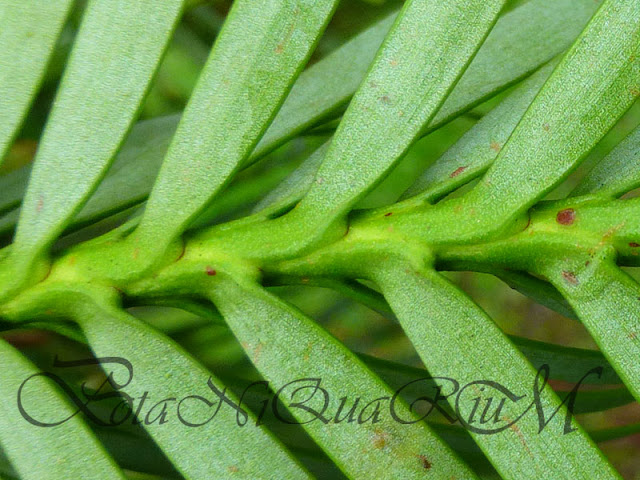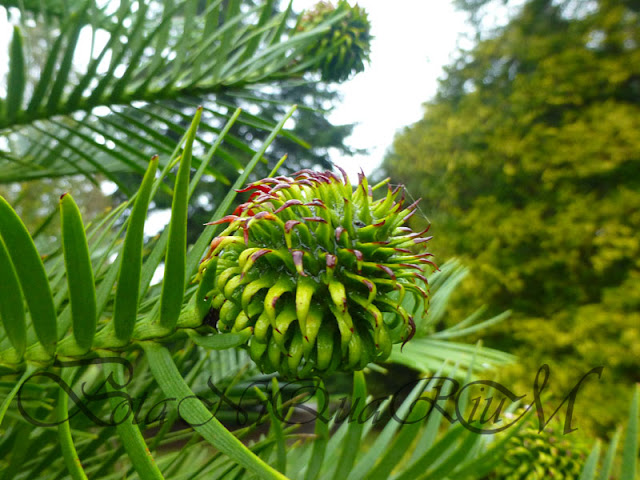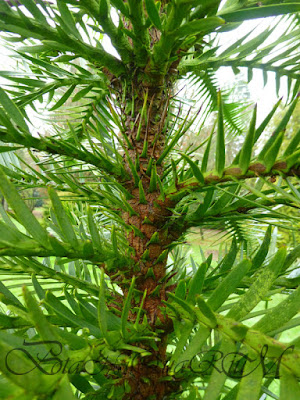Description:
This living fossil is an evergreen conifer and large tree, usually single-stemmed with a slender crown, mature specimen will develop young shoots from the base, eventually forming a thicket of multi-stemmed trees, suitable for growing in containers, monoecious as it carries both female and male cones on the same tree, female cones globose, covered in pointy bracts, male flowers are long stout cones that droop, foliage with long blueish-green needles that have a white hue (stoma) on the underside, lateral growing buds usually waxy, bark spongey and brown with nobbly scars. Heat will burn foliage.
Height: large tree, 40m ( I N ft)
 |
| Leaf underside with white stoma. |
 |
| Wollemia nobilis female cone. |
 |
| Wollemia nobilis male cone. |
Only recently discovered in 1994, a small surviving group of Wollemia nobilis was found in the Wollemi Canyon, Blue Mountains, New South Wales, Australia; David Noble introduced this tree to cultivation. Soon all important botanic gardens and collections were given a specimen ensuring its survival. There is an extensive conservation program run by the Royal Botanic Gardens Sydney, this includes seed collecting by helicopter in the Wollemi National Park, Australia, propagating and sharing specimen, as well as more importantly keeping its only native growing location top secret.
| By 2006 all major botanic gardens had a Wollemia nobilis. All plants had to be protected with a strong physical barrier as well as secured with a root anchor in the ground as they were so precious. Image Source: Kew Gardens |
 |
| The bark is brown and spongey, developing nobbly scars later. |
No pruning required, any pruning will usually ruin the tree, keep competition from other plants to a minimum, new plants should be staked to avoid wind rock. Remove stake after two years when established.
Propagation:
Best done by seeds, however, cuttings are possible too. This will usually ruin the specimen as only the terminal bud can be used.
Meaning of plant name:
WOLLEMIA: from Wollemi Canyon, Blue Mountains, New South Wales, Australia, where this living fossil has been found in 1994
NOBILIS: famous, grand, noble
Origin: Australia (New South Wales), in deep sandstone gorges were there is warm, temperate rainforest vegetation.
Growing conditions:
We are still learning about this tree, as it has only been known since its recent discovery in 1994. Young plants that are less than ten years old suffer in the hot Australian sun and therefore need protection (shady to partial-shady locations), however in the UK where the sun and heat are much less intense, protection from sunlight is only needed during exceptionally hot parts of the summer, they prefer cool shaded roots in moist soild, will not tolerate boggy conditions, suitable for growing in containers as long as kept moist at all times, thrives in extreme acid soils with their natural habitat having a pH as low as 4, will tolerate neutral soils, does not like alkaline conditions on chalk, best grown on loam and sandy soils, on clay only with thorough drainage to avoid waterlogged condition, naturally grows on poor soil yet responses well to fertilizer or richer soils.
 |
| Wollemia nobilis as it was found 1994 in Australia, in a steep gorge protecting the trees from fires.
Image Source: Royal Botanic Gardens Sydney |
Hardiness: H4 - Hardy throughout most of the UK (-10 to -5°C)
Pests and Diseases: usually no problems
Other useful information:
Rated as Critically Endangered (CR) according to IUCN Red List criteria.
Wollemia nobilis has been dubbed a 'living fossil' as it represents the only remaining member of an ancient genus dating back to the time of the dinosaurs, over 65 million years ago. This fascinating tree was only discovered recently, causing great excitement in the botanical and horticultural worlds.
 |
| Hardy to approx. -10°C in the UK. |
 |
| A young Wollemia nobilis at the Walled Gardens of Cannington, UK |
 |
| Juvenile foliage on Wollemia nobilis |
 |
| Female cones on Wollemia nobilis |
 |
| Wollemia nobilis growing since 2006 at the Sir Harold Hillier Arboretum, UK |
Have a look at Related Species
